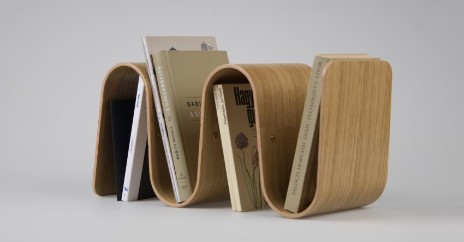In the Rhythm of Lines – Redefining the Bookend

The average European lives surrounded by around ten thousand objects. It’s no wonder our senses often feel saturated, and new things rarely bring true joy. Today, the essential skill is not accumulation but the art of selection: knowing what we allow into our lives and where we direct our attention. This approach is relevant not only when choosing books but also when selecting the accessories that become part of our everyday surroundings — whether a bookend, a magazine rack, or any object that balances order and aesthetics.
FROM PILES TO ORDER
As a beginner book or magazine collector, your volumes start to pile up on the bureau. Later, they form miniature skyscrapers on the floor until you eventually need an entire bookcase. While
Umberto Eco’s legendary private library may still feel out of reach — where it takes minutes to walk through the aisles before finding the right book — the need for order is universal among readers. Not every book deserves a place on the shelf: many people read e-books first and purchase only the truly defining works in physical form. Those we return to with joy, that move us emotionally, and that we are happy to lend to others. The same applies to accessories: only those worth keeping or acquiring that
combine aesthetic appeal with functionality, bringing calm and harmony into the space.
A NEW TAKE ON THE BOOKEND
But what can we do until we have an entire wall of bookshelves? Bookends help organise and preserve books, preventing damage to the covers. Traditional solutions consist of two separate end pieces that hold the books at both sides. They can be made of metal, plexiglass, or ceramic, and their design ranges from minimalist L-shapes to figurative sculptures. During the post-war revival of modern design, magazine holders began to introduce a new visual language. Flowing lines characterised them, the use of natural materials — especially wood — and cradle-like shapes that tamed the chaos of scattered magazines into gentle order. These pieces were often placed directly on the floor, where they served not only a practical purpose but also became iconic interior elements.
THE MEANDER INTRODUCES A NEW PERSPECTIVE
Breaking with tradition, designer Ádám Miklósi explored a new formal language: instead of two separate end pieces, he created a single, continuous wave-like curve made of plywood — a subtle nod to the world of mid-century modern magazine racks. The MEANDER’s unique feature is its modularity: with two end pieces and any number of middle elements, its length can be adjusted to suit different needs. The shortest version connects the two end pieces, while it can also be extended to accommodate longer rows of books. Its elegant curves, paired with the warmth of wood, make it a piece of both functional and aesthetic value. The name ‘Meander’ refers to the natural curves of a river, while also evoking the experience of reading — a free-flowing stream of thought found in every good book.
INSPIRATION AND FUNCTION
The concept draws inspiration from iconic magazine holders of the mid-20th-century modernist era, yet the designer reinterpreted the wave motif. The goal was to create an object that, while playful in form, maintains a refined, elegant aesthetic. Its proportions suit smaller books, magazines, and albums, and it is ideally placed on horizontal surfaces such as tables, shelves, or counters.
MORE THAN A BOOKEND - A MAGAZINE AND BROCHURE DISPLAY
The MEANDER bookend is not only suitable for home use but also offers new possibilities in professional environments. It works equally well as a bookend, magazine, or brochure holder — whether in offices, bookstores, showrooms, or exhibition stands. Unlike the cold, rigid plastic stands often used for such purposes, the plywood MEANDER offers a sophisticated alternative: its natural material and distinctive form highlight publications while keeping them neatly organised. Thus, MEANDER serves as both a decorative accessory and a practical display tool, seamlessly fitting into homes and corporate spaces alike.



.png)
.png)
.png)
.png)